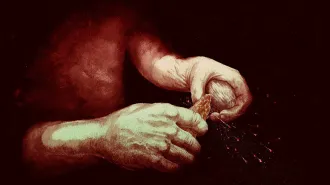Letters from the March 12, 2005, issue of Science News
Cheaters like us?
The model for the emergence of a population of “cheaters” out of a population of “cooperators” described in “When Laziness Pays: Math explains how cooperation and cheating evolve” (SN: 1/15/05, p. 35) gives a fresh viewpoint on existing ecosystems—and much more. Might the evolution of asymmetric modern sex from symmetric DNA exchange (like that practiced by paramecia) have been one special case of this emergence? If so, as a male, I prefer the more accurate terminology “high-investment participation” and “low-investment participation” over “cooperation” and “cheating.”
Stan Lyness
Auburndale, Mass.
Reptilian resemblance
I was disappointed in news coverage of the dinosaur find in China (“Reptilian Repast: Ancient mammals preyed on young dinosaurs,” SN: 1/15/05, p. 36). Science News and others ran an illustration with an obvious mistake. Unless the newly discovered mammal, Repenomamus giganticus, and its smaller cousin, Repenomamus robustus, were unique animals, they did not have legs that emerged from their sides giving them a sprawling, reptilian body plan. Surely, they would have had legs like all mammals, coming straight down from the hips and supporting the body. Not to put too fine a point on it, but there is also a problem with the Psittacosaurus in the background of the illustration. Recent finds in China suggest that this plant eater had a complement of porcupinelike quills running down its tail.
Howard Zimmerman
New York, N.Y.
Here comes the sun
Titan may represent conditions that existed on Earth when life arose (“A World Unveiled: Crème brûlée on Titan,” SN: 1/22/05, p. 51). One important difference is the extremely cold temperature on Titan. However, the known life cycle of stars predicts that, at some time in the far distant future, our sun will gradually expand. As that happens, Titan will heat up, and that may be sufficient for life to take hold there. Perhaps our descendants will be able to use Titan as a haven from the sun’s expansion.
Rubin Boxer
Santa Barbara, Calif.







